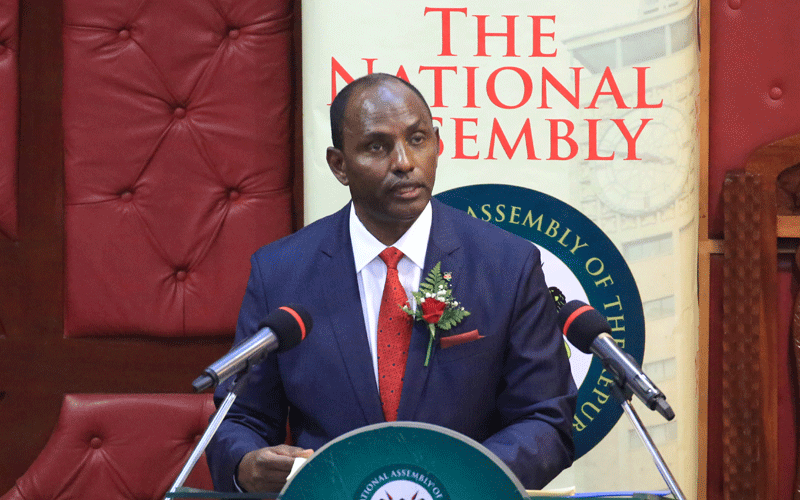Yatani unveils Sh2.8 trillion Budget for economic recovery
By Seth Onyango, June 12, 2020Seth Onyango @Sethmanex
National Treasury Cabinet Secretary Ukur Yatani yesterday put on a brave face, unleashing an expensive budget that sought to balance the tricky matrix of safeguarding lives and setting an ambitious stage for economic recovery.
Against a backdrop of a struggling economy ravaged by the coronavirus pandemic which has so far infected more than 3,000 people locally, the minister unveiled a spending plan that left many questions on the source of funding, even as vulnerable Kenyans took the centre stage of his estimates.
In his Sh2.8 trillion inaugural budget, which excludes Sh441 billion in redemptions, the CS shelled out Sh56.6 billion through an eight-point economic stimulus programme to boost liquidity in the business sector and to cushion vulnerable Kenyans from the pandemic and its associated shocks.
In total, Sh1.9 trillion will go to the National Government, Sh1.02 trillion to the Consolidated Fund services and Sh316.5 billion to county governments.
To cushion Kenyans against the adverse effects of the pandemic and increase liquidity in the economy, the government had earlier lowered tax rates for corporate and personal incomes, turnover tax, value added tax and provided tax relief to low income earners and employees.
Stimulus package
“These measures are estimated to cost the Exchequer Sh172.0 billion in revenue foregone by the government in one financial year,” Yatani said yesterday.
In his first budget speech since taking over from Henry Rotich, the minister focused on eight thematic areas, namely, infrastructure, employment, education, health, Small and Medium Enterprises (SMEs), agriculture, tourism and manufacturing.
In a move aimed at putting some money in the pocket of the youth, the government hopes to hire over 220,000 Kenyans, most of them unskilled, in a bid to accelerate the trickle down of cash to the grassroots and reinvigorate the ailing economy.
“The Stimulus Programme will focus on keeping the food supply chains functional while promoting the use of locally produced goods and services, thus securing the livelihoods of daily wage earners,” said Yatani.
On agriculture, the government has set aside Sh3 billion to subsidise the supply of farm inputs through the e-voucher system to reach 200,000 small scale farmers.
“I have also allocated Sh3.4 billion for expanded community household irrigation. This will cushion farmers from the adverse effects of weather and further secure food supply chains,” he said.
At the same time, the government injected Sh15.5 billion allocation to the ambitious Affordable Housing Programme.
On national debt, he outlined the government’s plan to scale down on commercial loans as part of Kenya’s debt management strategy.
This comes on the back of runaway public debt which now stands at Sh6.2 trillion, Sh3.8 billion shy of the nation’s Sh10 trillion Gross Domestic Product (GDP).
In his budget statement yesterday, the CS said the government will target more concessional loans that are advanced on terms substantially more generous than market loans.
“The government is committed to implement the 2020 Medium Term Debt Strategy which recommends a shift towards concessional external borrowing and lengthening of maturity structure of the domestic debt,” he told the bicameral Parliament.
“In addition, the Debt and Borrowing Policy approved in early 2020 will guide management of public debt.”
This is against the projected revenues and expenditures in the financial year 2020/21, the fiscal deficit, including grants expected to shrink to Sh840.6 billion (7.5 per cent of GDP) from Sh842.7 billion (8.3 per cent of GDP) in the financial year 2019/20.
Investment analyst Aly-Khan Satchu told the People Daily the prevailing Covid-19 economic climate portends more doom for the local economy which will struggle to meet its loan obligations.
“It is highly unlikely that Kenya will post a positive GDP outcome this year. The tourism forecast is hard pressed, remittances down by around 20 per cent, floriculture sector under water and with a weak overall economy, this means Treasury expects a flat year-on-year outcome,” he said.
This year, Sh369.9 billion has been allocated to counties Sh316.5 in equitable share and Sh13.7 billion on conditional allocation from the national government.
At least Sh30.2 billion of the allocation will come from external loans and grants while Sh9.4 billion from the road maintenance levy fund.
Yatani revised the fiscal framework for the 2020/21 budget and the medium term to take into account the adverse impact of the Covid-19 pandemic on revenue performance.
In this respect, the budget targets revenue collection including Appropriations-in-Aid (AIA) of Sh1.89 trillion, equivalent to 16.8 per cent of GDP, a stagnation from the estimated revenues of Sh1.89 trillion, equivalent to 18.6 per cent of GDP in the financial year 2019/20.
Of this, ordinary revenues in the financial year 2020/21 are projected at Sh1.63 trillion, equivalent to 14.5 per cent of GDP.
Recurrent expenditure
Total expenditures in the financial year 2020/21 are projected at Sh2.79 trillion or 24.7 per cent of GDP from the estimated level of Sh2.77 trillion, reflecting 27.2 per cent of GDP in 2019/20.
That includes the recurrent expenditures amounting to Sh1.82 trillion or 16.2 per cent of GDP.
With debate on a constitutional referendum gaining steam, Yatani yesterday left open the possibility of the vote that is being fronted by President Uhuru Kenyatta and opposition chief Raila Odinga being held before July 30, 2021.
But the government has an option of making changes in the budget through a supplementary vote within the financial year should the need arise.
Reacting to concerns that a referendum cannot happen unless there is a specific allocation for it, Kitui Central Member of Parliament Makali Mulu, a member of the House Budget and Appropriation Committee, recently argued that Treasury can still release money for the plebiscite even if it is not factored in the Budget.
“The law allows Treasury to spend and then come to Parliament for regularisation. Money can be spent on a plebiscite and then the CS comes to Parliament for the expenditure to be regularised,” he explained.
